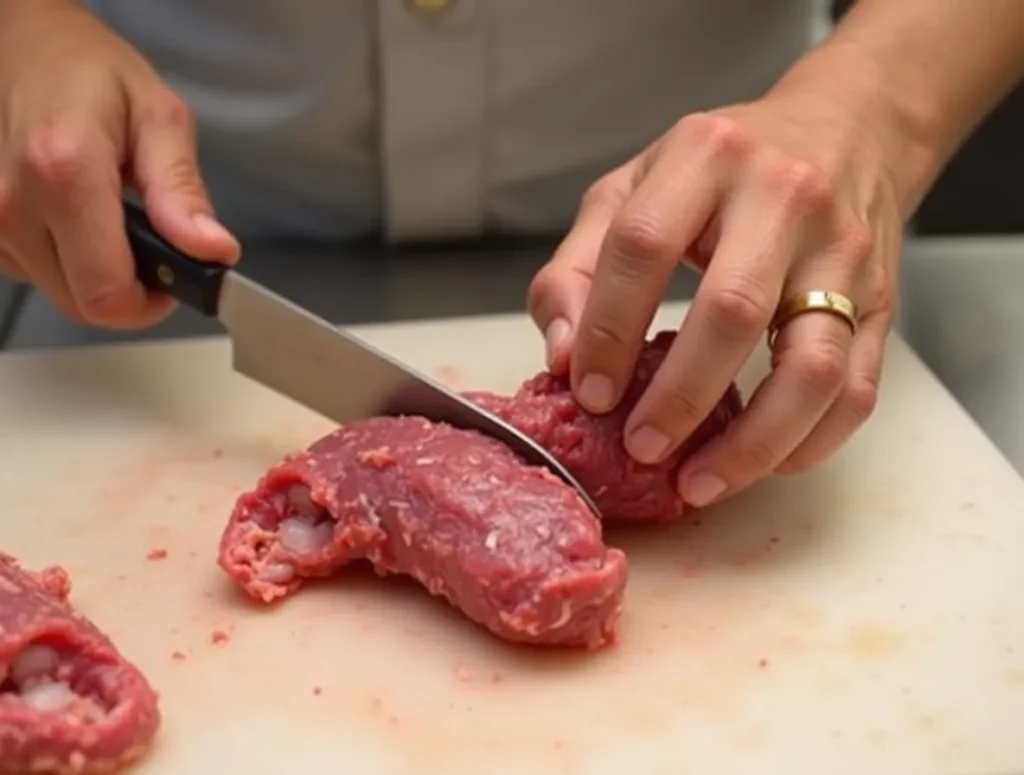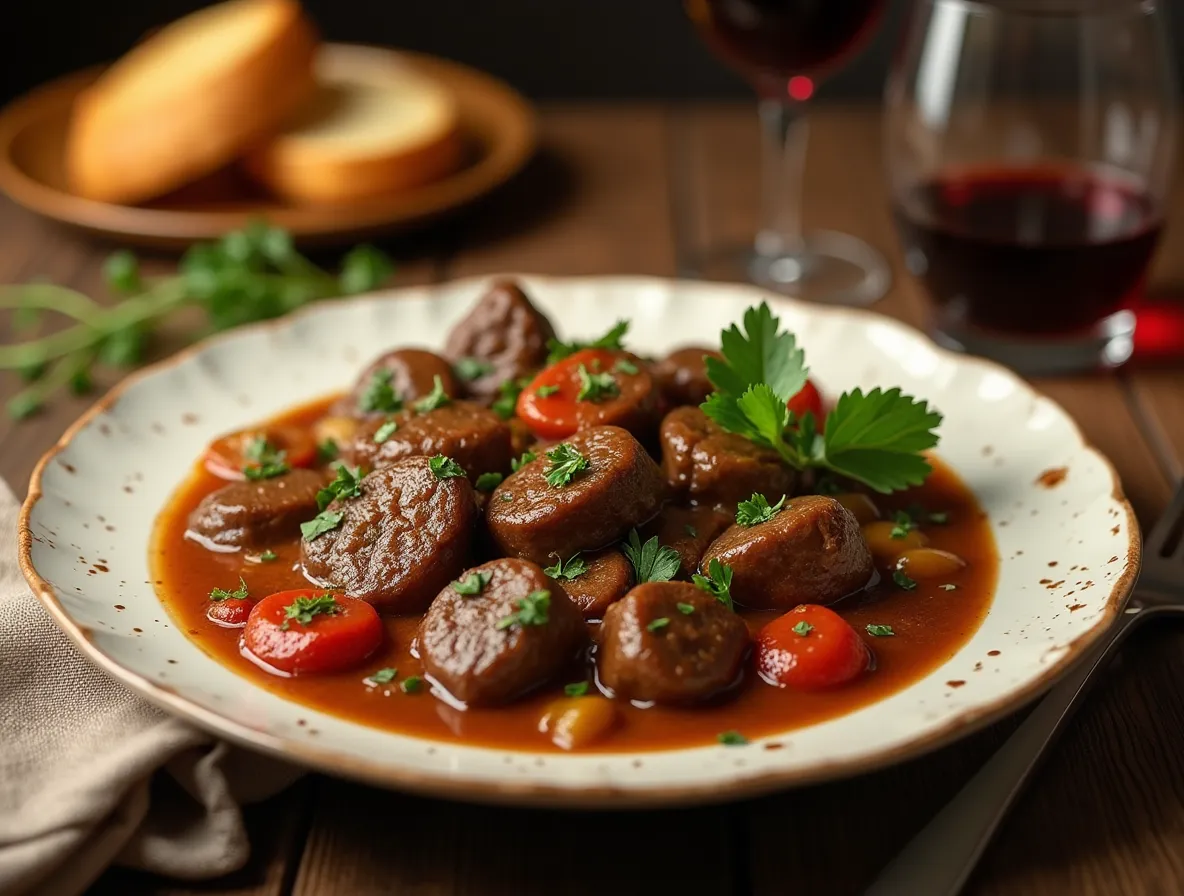Table of Contents
Cooking beef kidney might seem intimidating at first, but with the right preparation and techniques, it can become a mouthwatering delicacy. Whether you’re a fan of offal or a curious cook looking to expand your culinary skills, beef kidney is a flavorful and nutrient-dense ingredient that deserves a spot on your table. Let’s explore everything you need to know about preparing beef kidney, from selecting the freshest cuts to cooking up delicious recipes.
Introduction to Beef Kidney
What Are Beef Kidneys?
Beef kidneys are organ meats, part of a category often called offal. Found in cows, these bean-shaped organs play an essential role in the animal’s body. When prepared correctly, they transform into a tender, slightly gamey ingredient that absorbs flavors beautifully, making them a unique addition to various recipes.
Why Cook Beef Kidneys? Nutritional Benefits
Why should you consider adding beef kidneys to your diet? These organs are nutritional powerhouses! They’re loaded with essential vitamins like B12, niacin, and riboflavin, as well as minerals such as iron, selenium, and zinc. Plus, they’re high in protein and low in fat, making them perfect for health-conscious eaters.
Block Quote Example:
“Beef kidneys are an underrated superfood, offering vital nutrients like B12, which boosts energy levels, and selenium, which supports your immune system.”
Common Misconceptions About Beef Kidney
Many people shy away from offal due to its strong flavor or unfamiliarity, but these concerns are easily addressed. With proper cleaning and preparation, beef kidneys lose their intense odor and become tender and flavorful. If you’ve avoided them before, now’s the time to reconsider!
How to Choose Fresh Beef Kidney
Tips for Selecting the Best Quality Kidney
When shopping for beef kidneys, freshness is key. Here’s what to look for:
- Color: Fresh kidneys should have a vibrant reddish-brown hue. Avoid kidneys with dull or grayish spots.
- Texture: The surface should be firm and smooth to the touch, not slimy or mushy.
- Smell: Fresh kidneys have a mild, clean scent. If it smells overly strong or unpleasant, it’s likely past its prime.
Signs of Freshness
Freshness determines the taste and quality of your final dish. Look for kidneys that are intact, free of any tears or blemishes, and appear moist but not overly wet.
Where to Buy Beef Kidney
You can find beef kidneys at local butcher shops, specialty meat markets, and even some supermarkets. For the best quality, opt for grass-fed or organic sources. Alternatively, check out online retailers that specialize in organ meats for a wider selection.
Preparing Beef Kidney: Essential Steps
Cleaning the Kidney
Cleaning is arguably the most important part of preparing beef kidneys. Start by rinsing them under cold water to remove any surface impurities. Then, carefully trim away the white fatty tissue and membrane surrounding the kidney.
Pro Tip: Use a sharp knife and take your time during trimming—it’s worth the effort to ensure a clean flavor.
Removing the Tough Membrane
The membrane is a chewy layer that covers the kidney. To remove it, make a small slit in the membrane, then gently peel it away. This step significantly improves the texture of the final dish.
Soaking to Remove Odors
Soaking the kidneys is an optional but highly recommended step to reduce any strong odors. Submerge the kidneys in a mixture of water and vinegar or milk for 30 minutes to an hour. This helps to mellow the flavor and improve the overall taste.
Cutting Techniques for Cooking
Once cleaned and soaked, it’s time to cut the kidneys. Slice them into uniform pieces for even cooking. If you’re making a stew, cubing is a great option, while thin slices work well for stir-fries.

Cooking Methods for Beef Kidney
Pan-Frying Beef Kidney: Quick and Flavorful
Pan-frying is one of the fastest ways to cook beef kidneys. Heat a skillet with a bit of oil or butter, add the kidneys, and cook on medium-high heat for 3–5 minutes per side until golden brown. Add onions, garlic, or your favorite spices for extra flavor.
Slow Cooking for Tender Results
Slow cooking transforms beef kidney into a tender, melt-in-your-mouth treat. Add kidney pieces to a slow cooker with stock, vegetables, and seasonings, and let it simmer for several hours. This method works wonderfully for stews and casseroles.
Grilling or Barbecuing Beef Kidney
Grilling beef kidneys adds a smoky, charred flavor that pairs beautifully with their rich taste. To prepare, marinate the kidney pieces in a mixture of olive oil, lemon juice, garlic, and herbs for about 1–2 hours. Skewer the pieces and grill them over medium heat for 3–4 minutes on each side. They’re perfect as a standalone dish or served alongside grilled vegetables.
Pairing with Spices and Herbs
Beef kidneys are incredibly versatile and work well with a wide range of spices and herbs. Here are some popular options:
- Herbs: Rosemary, thyme, parsley, and bay leaves.
- Spices: Paprika, cumin, coriander, and black pepper.
- Other Additions: Garlic, onions, and mustard are classic pairings that enhance the flavor of kidneys.
Pro Tip: Use bold flavors to complement the kidneys’ natural richness without overpowering them.
Popular Beef Kidney Recipes
Traditional Beef Kidney Stew
A hearty beef kidney stew is a comforting dish packed with flavor. Here’s a basic recipe to get you started:
- Ingredients:
- 2 beef kidneys, cleaned and cubed
- 2 tablespoons olive oil
- 1 onion, finely chopped
- 2 garlic cloves, minced
- 3 carrots, sliced
- 2 potatoes, diced
- 4 cups beef stock
- 1 teaspoon thyme
- Salt and pepper to taste
- Instructions:
- Heat the olive oil in a large pot and sauté the onions and garlic until fragrant.
- Add the kidney pieces and cook until lightly browned.
- Stir in the carrots, potatoes, thyme, salt, and pepper.
- Pour in the beef stock and bring the mixture to a boil.
- Reduce the heat, cover, and let simmer for 1–2 hours until the vegetables and kidneys are tender.
Kidney Stir-Fry with Vegetables
For a quick and healthy meal, try a kidney stir-fry. Combine kidney slices with bell peppers, onions, and snap peas, then toss them in a soy sauce-based stir-fry sauce. Serve over steamed rice for a satisfying dinner.
Creamy Beef Kidney Sauce for Pasta
If you’re a fan of rich, creamy sauces, this recipe is a must-try. Sauté kidney slices with mushrooms and onions, then deglaze the pan with white wine. Add heavy cream, season with salt, pepper, and nutmeg, and simmer until thickened. Pour over pasta or serve with crusty bread.
Overcoming Common Problems
How to Reduce the Strong Odor
One of the most common concerns with beef kidneys is their distinct smell. Here’s how to minimize it:
- Soaking: Soak the kidneys in milk or a vinegar-water solution before cooking.
- Trimming: Thoroughly remove the fatty tissue and membrane, as they often contribute to the odor.
- Seasoning: Use bold flavors like garlic, mustard, or lemon juice to mask any lingering scent.
Avoiding Toughness While Cooking
Nobody wants to chew on tough, rubbery kidney pieces! To ensure tenderness:
- Don’t Overcook: Cook kidneys quickly over high heat or slowly over low heat. Avoid medium cooking temperatures, as they can make the kidneys tough.
- Cut Uniformly: Evenly-sized pieces cook more consistently, preventing tough spots.
- Use Acids: Marinades with lemon juice, vinegar, or wine can help break down muscle fibers, resulting in a softer texture.
Ensuring Balanced Flavors
Kidneys have a strong, rich flavor that benefits from careful seasoning. Balance their intensity by pairing them with acidic ingredients (like tomatoes or lemon juice) and hearty vegetables like potatoes or carrots. Sweet flavors, such as caramelized onions or a touch of honey, also work beautifully.
Block Quote Example:
“Balancing the bold flavor of kidneys is all about complementing their richness with contrasting ingredients like herbs, acids, and hearty vegetables.”
Serving Suggestions
Perfect Side Dishes for Beef Kidney
Pairing the right side dishes with beef kidney can elevate the entire meal. Here are a few suggestions:
- Mashed Potatoes: Creamy potatoes balance the richness of kidneys.
- Steamed Vegetables: Light and fresh greens like broccoli or green beans provide a refreshing contrast.
- Rice or Couscous: These grains soak up the delicious juices from kidney dishes.
Plating and Presentation Tips
Presentation matters, especially when serving an unconventional dish like beef kidneys. Arrange the kidneys with vibrant vegetables on a clean white plate for visual appeal. Garnish with fresh herbs like parsley or thyme to add a pop of color.
Nutrition Facts of Beef Kidney
| Nutrient | Amount Per 100g | Health Benefits |
|---|---|---|
| Calories | 100 kcal | Low-calorie protein source |
| Protein | 16g | Supports muscle growth and repair |
| Iron | 7mg | Promotes healthy red blood cell production |
| Vitamin B12 | 25μg | Boosts energy and nerve function |
| Selenium | 150μg | Strengthens the immune system |
Block Quote Example:
“Beef kidneys are a nutritional goldmine, offering high protein and essential vitamins while being surprisingly low in calories.”
FAQs About Beef Kidney Preparation
Is It Safe to Eat Beef Kidney Often?
Yes, beef kidneys are safe to eat when consumed in moderation. They are rich in nutrients, but because of their high purine content, individuals with gout or similar conditions should limit their intake. Incorporating kidneys into your diet once or twice a week can provide nutritional benefits without overloading on organ meats.
How Long Can You Store Prepared Kidney?
Cooked beef kidneys can be stored in the refrigerator for 3–4 days in an airtight container. To keep them fresh, ensure they’re completely cooled before storing. If you have leftovers you won’t eat right away, freezing is an excellent option.
Can Beef Kidney Be Frozen?
Absolutely! Raw and cooked kidneys can both be frozen for longer storage. Here’s how to do it:
- Clean and prepare the kidneys thoroughly before freezing.
- Wrap them tightly in plastic wrap or place them in freezer-safe bags.
- Label with the date to keep track of storage time.
Raw kidneys can be frozen for up to 3 months, while cooked kidneys are best used within 1–2 months for optimal taste and texture.
Can I Prepare Beef Kidney Without Soaking It?
Yes, but soaking is recommended to improve the flavor and reduce the strong odor. If you’re short on time, thorough cleaning and proper cooking techniques can also help achieve a delicious result.
Are Beef Kidneys Suitable for All Diets?
Beef kidneys are suitable for many diets, including paleo, keto, and low-carb plans. However, they may not be ideal for vegetarians, vegans, or individuals with specific medical restrictions. Always consult with a healthcare professional if you’re unsure.
Why Does My Beef Kidney Dish Taste Bitter?
Bitterness usually results from improper cleaning or failing to remove the membrane and fatty tissue. Double-check your preparation process to ensure all these parts are trimmed away. Additionally, soaking in milk or vinegar can reduce bitterness significantly.
Conclusion
Preparing beef kidneys might feel like a culinary challenge at first, but with the proper techniques, it’s easier than you think. From selecting fresh, high-quality kidneys to cleaning, marinating, and cooking them to perfection, this guide covers all the steps to ensure a delicious and nutritious meal.
Whether you’re pan-frying them for a quick dinner, slow-cooking them for a tender stew, or experimenting with flavorful spices, beef kidneys are a versatile ingredient that can elevate your cooking skills. Plus, their impressive nutritional profile makes them an excellent choice for anyone looking to incorporate more organ meats into their diet.
So, why not step out of your comfort zone and give beef kidney a try? With the tips and recipes in this guide, you’re all set to make a dish that’s both flavorful and satisfying.

